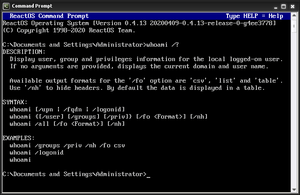whoami
In computing, whoami is a command found on most Unix-like operating systems, Intel iRMX 86, every Microsoft Windows[1] operating system since Windows Server 2003, and on ReactOS. It is a concatenation of the words "Who am I?" and prints the effective username of the current user when invoked.
 The ReactOS whoami command | |
| Developer(s) | Bill Joy, Richard Mlynarik, Intel, Microsoft, ReactOS Contributors, Novell |
|---|---|
| Operating system | Unix, Unix-like, iRMX 86, Windows, ReactOS, NetWare |
| Type | Command |
| License | BSD: BSD License coreutils: GPLv3 iRMX 86, Windows, NetWare: Proprietary commercial software ReactOS: GPLv2 |
Overview
The command has the same effect as the Unix command id -un. On Unix-like operating systems, the output of the command is slightly different from $USER because whoami outputs the username that the user is working under, whereas $USER outputs the username that was used to log in. For example, if the user logged in as John and su into root, whoami displays root and echo $USER displays John. This is because the su command does not invoke a login shell by default.
The earliest versions were created in 2.9 BSD as a convenience form for who am i, the Berkeley Unix who command's way of printing just the logged in user's identity. This version was developed by Bill Joy.[2]
The GNU version was written by Richard Mlynarik and is part of the GNU Core Utilities (coreutils).
The command is available as a separate package for Microsoft Windows as part of the GnuWin32 project[3] and the UnxUtils collection of native Win32 ports of common GNU Unix-like utilities.[4]
On Intel iRMX 86 this command lists the currents user's identification and access rights.[5]
The command is also available as part of the Windows 2000 Resource Kit[6] and Windows XP SP2 Support Tools.[7]
The ReactOS version was developed by Ismael Ferreras Morezuelas and is licensed under the GPLv2.[8]
This command was also available as a NetWare-Command residing in the public-directory of the fileserver. It also outputs the current connections to which server the workstation is attached with which username.
Example
Unix, Unix-like
# whoami
root
Intel iRMX 86
--WHOAMI
USER ID: 5
ACCESS ID'S: 5, WORLD
Windows, ReactOS
C:\Users\admin>whoami
workgroup\admin
See also
- logname
- id
- who
- User identifiers for Unix
- List of Unix commands
References
- Microsoft TechNet Whoami article
- 2.9.1BSD Manual Page
- CoreUtils for Windows
- Native Win32 ports of some GNU utilities
- iRMX™86 INTRODUCTION AND OPERATOR'S REFERENCE MANUAL For Release 6
- Windows 2000 Resource Kit Tool: Whoami.exe
- Windows XP Service Pack 2 Support Tools
- https://github.com/reactos/reactos/blob/master/base/applications/cmdutils/whoami/whoami.c
Further reading
- Barrett, Daniel J. (2012). Macintosh Terminal Pocket Guide: Take Command of Your Mac. O'Reilly. ISBN 978-1449328986.
- Stanek, William R. (2008). Windows Command-Line Administrator's Pocket Consultant, 2nd Edition. Microsoft Press. ISBN 978-0735622623.
External links
| Wikibooks has a book on the topic of: Guide to Windows Commands |
- – 4.2BSD General Commands Manual
- – FreeBSD General Commands Manual
- whoami | Microsoft Docs